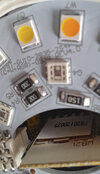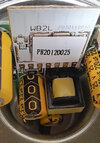...although if they are RGB strips, their efficiency producing 'white' light is significantly reduced, over an RGBW strip.
Not really looked at the TCP ones, but the Livarno has three sets of LED's, one colour, one low temperature white and one high temperature white. So when on white light the colour LED's are not lit, and as you adjust the colour temperature of the white light one set dims down and the other set goes brighter.
The strip can produce way over the rated 22 watt, but the controller will not allow both the low and high temperature LED to be fully powered together. It is likely the same with bulbs, but the defuser plastic over the LED's does not let you see what is there.

This is a GU10 I ripped open and it seems to show the three chips in the same way as with the strip lamp. The control circuits seem quite complex

which may explain why I have more failures with smart bulbs than standard bulbs. However the old idea of a dimming switch no longer works, as when you dim an LED the colour temperature remains static, so to get the ambiance it needs to be a smart bulb so you can also change the colour when dimming.
It seems we have come to the end of the digital age where things had two states on or off, and have moved into the analogue age where we can adjust brightness of lights, and output of boilers, and input of radiators gradually rather than using a mark/space ratio.
My living room I feel was never bright enough from the day the house was built, it was far too big of a room for a single pendent light, the chandelier helps,

the ceiling mouldings means hard to fit lighting track, and the 8 bulbs really means it drops too low, so only way is standard lamps, mainly with up lighters, or table lamps, or display cabinet lights, it has been a problem lighting the house with sheet flooring so can't lift floor boards to wire in new.





